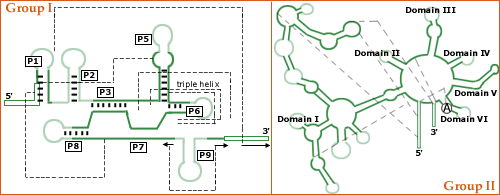Different Types of IntronsSince the discovery of introns in pre-mRNA, other types of introns have also been identified. We now know of 4 types of introns: introns in tRNA genes, group I introns, group II introns and pre-mRNA introns. The tRNA introns are special because they are removed by an enzyme which cuts the RNA, after which other enzymes phosphorylate (protein kinase) and religate the two halves of the tRNA. Group I introns are widespread and present in mRNA, tRNA and rRNA in mitochondria, chloroplasts and nuclear genomes of non-vertebrates, in bacteriophages and in eubacterial genomes. All group I introns share the same folding pattern. Group I introns were studied by Tomas Cech, who found that group I introns can be excised in the complete absence of any proteins. This discovery led to the concept of RNA enzymes and has had great influence on our thinking on the evolution of life on earth. Tomas Cech shared the Nobel prize in 1989 with Sidney Altman who discovered that another type of RNA, RNAse P could catalyse the cleavage of the tRNA precursors.
Group II introns are found in mitochndria and chloroplasts, but have also been observed in cyanobacteria and proteobacteria. All group II introns also share a common folding pattern. As for group I introns, group II introns can self-splice. In vivo, splicing of both group I and II introns involves proteins. The reaction mechanism of group II intron excision is exactly the same as for pre-mRNA introns and it is possible that pre-mRNA introns and group II introns are evolutionally related. If so, the snRNAs may originate from group II introns.
|
|||
 |
|||
|
Origin of IntronsThe fact that introns are
present in genes has been used during evolution to
evolve alternative
splicing as a
process to regulate gene expression. It has also made
it possible to build new genes by combining exons in
different combinations, so-called
exon shuffling.
Several such genes are present in mammalian
organisms. |
